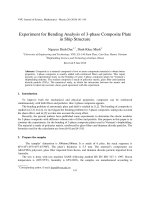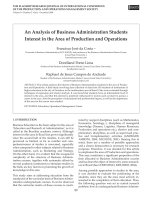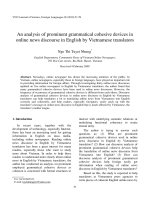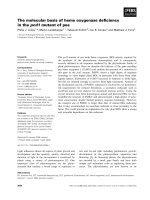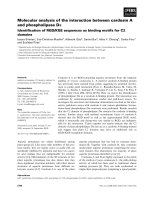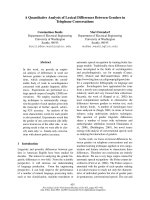Molecular analysis of the roles of yeast microtubule associated genes in agrobacterium mediated transformation
Bạn đang xem bản rút gọn của tài liệu. Xem và tải ngay bản đầy đủ của tài liệu tại đây (2.72 MB, 208 trang )
Molecular analysis of the roles of yeast
microtubule-associated genes in
Agrobacterium-mediated transformation
Chen Zikai
(B. Sc.)
A THESIS SUBMITTED
FOR THE DEGREE OF DOCTOR OF PHILOSOPHY
DEPARTMENT OF BIOOGICAL SCIENCES
NATIONAL UNIVERSITY OF SINGAPORE
2012
I
ACKNOWLEDGEMENTS
First of all, my deepest gratitude goes to my supervisor, Associate Professor Pan
Shen Quan, not only for providing me the precious opportunity to undertake this
promising project but also for his patient encouragement, professional and practical
guidance throughout my PhD candidature.
Secondly, I would like to express my sincere gratitude to Professor Wong Sek
Man, A/P Yu Hao and Xu Jian for their valuable instruction and general support to my
research program. I would also like to thank Ms Tan Lu Wee and Xu Songci for their
continuous assistance and support in my experimental manipulation. Moreover, I am
also indebted to Ms Tong Yan and Mr Yan Tie for their technical help in fluorescent
and confocal microscopy.
I am also grateful to the following friends and laboratory members who have
been helping me in different ways: Sun Deying, Tu Haitao, Yang Qinghua, Lim Zijie,
Gao Ruimin, Wang Bingqing, Li Xiaoyang, Niu Shengniao, Wen Yi, Wang Yanbin,
Gong Ximing, etc. Moreover, I must thank my family for their moral support and
persistent encouragement during the four years’ PhD study.
Finally, I gratefully acknowledge National University of Singapore for providing
me the research scholarship to conduct this interesting project.
II
TABLE OF CONTENTS
ACKNOWLEDGEMENTS I
TABLE OF CONTENTS II
SUMMARY VIII
LIST OF MANUSCRIPTS X
LIST OF TABLES XI
LIST OF FIGURES XII
LIST OF ABBREVIATIONS XV
CHAPTER 1. LITERATURE REVIEW 1
1.1. Overview of the structure and functions of microtubules 1
1.1.1. The properties of tubulins in yeast cells 2
1.1.2. Motor proteins associated with microtubules 4
1.1.3. The function of microtubules in mRNA trafficking 5
1.1.4. The hijacking of microtubules by pathogens 6
1.1.5. The exploitation of microtubules by Agrobacterium? 7
1.2. Introduction to Agrobacterium tumefaciens 8
III
1.3. Molecular mechanisms involved in Agrobacterium-mediated gene transfer 9
1.3.1. The chemotaxis of Agrobacterium 10
1.3.2. Induction of vir genes in Agrobacterium 11
1.3.3. The attachment of Agrobacterium to the host cells 12
1.3.4. The generation of T-DNA and T-complex 13
1.3.5. Translocation of virulence factors through T4SS 16
1.3.6. The functions of virulent proteins imported into the host 17
1.3.7. T-complex transport and nuclear import 19
1.3.8. T-DNA targeting to the chromatin 22
1.3.9. T-DNA uncoating and integration 23
1.4. The response of the host cells to Agrobacterium infection 25
1.5. The Agrobacterium-yeast gene transfer 26
1.6. Aims of this study 28
CHAPTER 2. MATERIALS AND METHODS 31
2.1. Strains, culture media, common solutions plasmid and primers 31
2.2. DNA manipulations technique 39
2.2.1. Plasmid DNA preparation from E. coli 40
2.2.2. Total DNA preparation from S. cerevisiae 41
2.2.3. Genomic DNA preparation from Agrobacterium 41
2.2.4. DNA digestion and ligation 42
IV
2.2.5. Polymerase Chain Reaction (PCR) 42
2.2.6. Real-time PCR 44
2.2.7. DNA gel electrophoresis and purification 44
2.2.8. DNA sequencing 45
2.3. Transformation 46
2.3.1. Transformation of E. coli by heat shock 46
2.3.2. Transformation of S. cerevisiae by lithium acetate transformation 46
2.3.3. Agrobacterium-mediated transformation in S. cerevisiae 47
2.3.4. Transformation of Agrobacterium by electroporation 48
2.4. Protein preparation and analysis 49
2.4.1. Protein extraction from S. cerevisiae and protein assays 49
2.4.2. SDS-PAGE gel electrophoresis 52
2.4.3. Coomassie blue staining and Western blot analysis 53
2.5. Sample preparation and microscopy for cell imaging 55
CHAPTER 3. IDENTIFICATION OF YEAST
MICROTUBULES-ASSOCIATED GENES INVOLVED IN
AGROBACTERIUM-MEDIATED TRANSFORMATION PROCESSES 56
3.1. Introduction 56
3.2. Identification of microtubules-associated genes in AMT 59
3.2.1. Screening of yeast microtubule-related genes 59
V
3.2.2. Searching for genes consistently affecting AMT efficiency at different input
numbers and ratios of yeast to Agrobacterium 62
3.2.3. Lithium acetate transformation to confirm the effect of genes on AMT 66
3.3. Introduction of the H2A-H2A.Z exchanging complex 71
3.3.1. Overview of the histone variant H2A.Z 71
3.3.2. The functions of SWR1 complex and its homologs 72
3.4. The involvement of SWR1 complex in AMT process 74
3.4.1. AMT efficiencies of SWR1 subunit knockout mutants 74
3.4.2. Time course of AMT on WT and arp6∆ 77
3.4.3. Complementation and over-expression assays of ARP6 gene 80
3.5. Conclusion 84
CHAPTER 4. ARP6 REGULATES THE INTERACTION BETWEEN HOST
FACTORS AND VIRULENT PROTEINS 86
4.1. Introduction 86
4.2. Localization of Arp6p in S. cerevisiae 89
4.3. ARP6 regulates the dynamics of microtubules 91
4.3.1. Comparison of microtubule structures in WT and arp6∆ 92
4.3.2. Microtubules structure was changed during AMT process 94
4.3.3. Colchicine and oryzalin effect on microtubules 97
VI
4.4. The regulation of virulence proteins by ARP6 100
4.4.1. Arp6p may prohibit VirD2 from entering the host nucleus 100
4.4.2. VirD2 degradation was accelerated in arp6∆ strain 103
4.4.3. Overexpression of VirD2 decreases transformation efficiency 106
4.4.4. Transport amount of VirE2 is higher in arp6∆ strain 107
4.5. Conclusion 111
CHAPTER 5. T-DNA TRACKING DURING THE AMT PROCESS 113
5.1. Introduction 113
5.2. T-DNA detection in yeast cells by fluorescence in situ hybridization 113
5.2.1. Design of probes for FISH 115
5.2.2. Sample fixation and spheroplast preparation 115
5.2.3. Hybridization with specific probes 117
5.2.4. Results and discussion 118
5.3. T-DNA quantification by semi-quantitative PCR and Real-time PCR 126
5.3.1. Preparation of samples for PCR assay 126
5.3.2. Results and discussion 127
5.4. DNA probes tracing during AMT process 131
5.4.1. Agrobacterium takes in probes through T4SS 131
5.4.2. Probe imported into the yeast cell 134
VII
5.5. DNase activity assay for yeast cells 139
5.6. Conclusion 142
CHAPTER 6. GENERAL CONCLUSIONS AND FUTURE WORK 144
6.1. General conclusions 144
6.2. Future work 147
REFERENCES 149
VIII
SUMMARY
Agrobacterium tumefaciens can genetically transform plants in nature by
transferring a piece of DNA (T-DNA) into the host cell. Under laboratory conditions,
Agrobacterium can also transfer T-DNA into a wide range of other eukaryotic species,
including yeast cells. A. tumefaciens virulence machinery facilitating the transfer of
T-DNA has been intensively investigated; however, the trafficking pathway of T-DNA
inside eukaryotic cells is not well established.
It is reasonable to speculate that an active transport mechanism should be
involved in the process because macromolecules such as T-complex cannot simply
diffuse effectively through the dense cytoplasm. This project is using Saccharomyces
cerevisiae as a research model to investigate the trafficking pathway of T-DNA inside
yeast cells. The focus is on yeast microtubule-associated genes, since previous studies
have found that in vitro constructed T-complex can utilize a microtubule-based
transport pathway to deliver T-DNA to the host nucleus.
To identify the host factors involved in the T-DNA transfer process, we screened
185 yeast knockout mutants of genes associated with microtubules. The results
demonstrate that 15 genes associated with microtubules were important for the
T-DNA transfer. Interestingly, we found that several genes exerts their effects only
under certain conditions. This study reveals that an actin related protein gene ARP6 is
involved in the trans-kingdom genetic transformation: deletion mutation at ARP6
significantly and consitstantly increases the transformation efficiency.
IX
Arp6p is an important subunit of the SWR1 complex, which exchanges the
conventional histone H2A with a histone variant H2A.Z. Further study shows that
Arp6p may regulate the Agrobacterium-mediated transformation (AMT) process
partly through this chromatin remodeling complex since knockout of the other
subunits of the complex also increases transformation efficiency to some extent.
Compelmetation assay and LiAc transformation confirm the specific effect of ARP6
on AMT.
In order to elucidate the molecular functions of ARP6 on AMT, a combination of
genetic, biochemical, and bio-imaging approaches is adopted to investigate the
molecular pathway for T-DNA trafficking inside yeast cells. ARP6 is found to
modulate the interaction of host factors and virulent proteins imported into the yeast
cell. The nulear import and degradation of VirD2, the transportation of VirE2 from
bacteria to the yeast are all affected by the deletion of ARP6.
Last but not least, this study investigates the T-DNA tracking in the yeast cell,
showing that knockout of ARP6 influences AMT process not by increasing uptake of
T-DNA but by weakening the host defensive system that may destroy the foreign
DNA. Moreover, Fluorescent in situ hybridization and probe tracing assay provide a
model to elucidate the T-DNA trafficking mechanism.
X
LIST OF MANUSCRIPTS
Chen Z. and Pan S.Q. (2012) The actin related protein ARP6p is a multi-functional
effector in regulating Agrobacterium-mediated transformation (In preparation).
Chen Z. and Pan S.Q. (2012) T-DNA detection and trafficking in the yeast cell during
Agrobacterium-mediated gene transfer (In preparation).
XI
LIST OF TABLES
Table 2.1 Bacterial and yeast stains used in this study………………………… 32
Table 2.2 Media and solutions used in this study 34
Table 2.3 Concentration and solvent of antibiotics and other chemicals 35
Table 2.4 Plasmids used in this study 36
Table 2.5 Primers used in this study 38
Table 2.6 Components of binding buffer and elution buffer 51
Table 2.7 Preparation of gel and buffers for SDS-PAGE 53
Table 3.1 The functions of genes that may be involved in AMT process 62
Table 3.2 The different fold changes at different conditions 65
Table 3.3 The raw data for complementation and over-expression 81
Table 4.1 The import rates of VirE2 in pQH04/WT and pQH04/arp6Δ 109
Table 5.1 The percentage of T-DNA detected after co-cultivation for 24 h 122
Table 5.2 The percentage of T-DNA detected in the time course assay 124
Table 5.3 The Ct values for GFP, VirE2 and Act1 in the co-cultivation samples 130
XII
LIST OF FIGURES
Figure 1.1 The organization of molecular motors and the model of motor cooperation
along microtubules…………………… 5
Figure 1.2 The retrograde transport model of viruses 6
Figure 1.3 The basic molecular mechanism for the Agrobacterium-mediated gene
transfer 10
Figure 3.1 Fold of changes in AMT efficiency of the knockout mutants as compared
to wild type 61
Figure 3.2 AMT efficiency of WT yeast was greatly affected by input number and
ratio between yeast and Agrobacterium 65
Figure 3.3 The comparison between AMT (A) and LiAc transformation 67
Figure 3.4 The arp6Δ mutant consistently increased transformation efficiencies as
compared to WT 70
Figure 3.5 Fold changes of AMT efficiency of SWR1 mutants and htz1∆ 76
Figure 3.6 The effect of ARP6 on AMT process in the time course assay 79
Figure 3.7 Construction of plasmids for complementation and over-expression
assay 82
Figure 3.8 The results of complementation and over-expression assays 82
Figure 4.1 The schematic structure of the SWR1 complex 87
Figure 4.2 The principles for construction of Arp6p-GFP fusion protein in yeast
cells 90
Figure 4.3 The localization of Arp6p in yeast cells 93
XIII
Figure 4.4 The microtubule structures in WT and arp6Δ 93
Figure 4.5 The effect of AMT on microtubule structures and location 95
Figure 4.6 The effect of colchicine and oryzalin on AMT efficiency 97
Figure 4.7 The effect of colchicine and oryzalin on the formation of microtubules in
yeast 98
Figure 4.8 GFP-VirD2 expression in WT and arp6Δ and the percentage of GFP-VirD2
expression cells at different time points 102
Figure 4.9 Total protein and VirD2 degradation in WT (pYES2-GFP-VirD2) and
arp6Δ (pYES2-GFP-VirD2) 105
Figure 4.10 The effect of VirD2 overexpression in the yeast cells on AMT
efficiency 106
Figure 4.11 The VirE2 import in WT (pQH04) during AMT process 109
Figure 4.12 Reorganization of microtubules during different stages of cell cycles in
budding yeast 112
Figure 5.1 The GFP DNA sequence of pHT101 and the 4 probes targeting sites within
the GFP sequence 116
Figure 5.2 The test for specificity of GFP probes 121
Figure 5.3 The FISH results for co-cultivation mixture of yeast and Agrobacterium for
24 h 122
Figure 5.4 FISH for the Agrobacterium-arp6Δ co-cultivation time course
experiment 124
XIV
Figure 5.5 The semi-quantitative PCR result for 24 h and 48 h co-cultivation
mixture 128
Figure 5.6 The relationship between Ct values of VirE2 and GFP in
Agrobacterium 130
Figure 5.7 The uptake of DNA probes by Agrobacterium after induction 133
Figure 5.8 Probe tracking from Agrobacterium to yeast at different time points 136
Figure 5.9 The movement of probes within yeast cells after 48 h co-cultivation 138
Figure 5.10 The DNase activity of yeast lysates from WT and arp6Δ 141
XV
LIST OF ABBREVIATIONS
μg microgram(s) EDTA ethylenediaminetet acetic acid
μl microliter(s) EGTA ethylene glycol tetraacetic acid
μm micrometre FISH fluorescent in situ hybridization
A adenosine g grams or gravitational force
aa amino acid(s) G guanosine
Amp ampicillin GFP green fluorescence protein
AMT Agrobacterium-mediated transformation h hour(s)
AS acetosyringone His histidine
bp base pair(s) HRP horseradish peroxidase
BSA bovine serum albumin IPTG isopropyl-β-D-thiogalactoside
C cytidine kb kilobase(s) or 1000 bp
Cb carbenicillin kDa kilodalton(s)
Cef cefotaxime Km kanamycin
CM co-cultivation medium LB Luria-Bertani medium or lift border
DMSO dimethylsulfoxide Leu leucine
DAPI 4', 6-diamidino-2-phenylindole LiAc lithium acetate
DNA deoxyribonucleic acid M molar
DNase deoxyribonuclease MCS multiple cloning site(s)
dNTP deooxyribonucleoside triphosphate Met methionine
dsDNA double-stranded DNA mg milligram(s)
DTT dithiothreitol μ micro-
XVI
min minute(s) SAP shrimp alkaline phosphatase
ml milliliter(s) SD standard deviation or synthetic dropout
mM millimole SDS sodium dodecyl sulfate
mw molecular weight ssDNA single-stranded DNA
N asparagines T thymidine or threonine
n nano- T4SS type IV secretion system
NLS nuclear localization signal T-DNA transferred DNA
nm nanometer UV ultraviolet
nt nucleotide(s) V voltage
OD optical density v/v volume per volume
ORF open reading frame WT wild type
p pico- w/v weight per volume
PCR polymerase chain reaction
PAGE polyacrylamide gel electrophoresis
PMSF Phenylmethanesulfonyl floride
R/r resistant/resistance
RB right border
RNA ribonucleic acid
RNase ribonuclease
rpm revolutions per min
s second(s)
S sensitive/sensitivity
Chapter 1. Literature review
1.1. Overview of the structure and functions of microtubules
Microtubules (MTs) are one of the essential cytoskeletons for various cellular
processes, including the maintenance of cell structure and polarity, the intracellular
transport of organelles and vesicles, as well as the assembly and function of the
mitotic spindle (Straube et al., 2003). MTs are hollow, 25 nm wide tubes which are
composed of 13 α- and β-tubulin heterodimeric protofilaments which are highly
conserved (Little and Seehaus, 1988) in nature, creating a plus and a minus end
(Valiron et al., 2001; Lichius et al., 2011). Because of the inherent polarity in the
structure of the heterodimers, the plus end of MT shows dynamic instability behavior,
switching stochastically and rapidly between phases of polymerization and
depolymerization (Mitchison and Kirschner, 1984; Desai and Mitchison, 1997;
Nogales, 2000). The unique dynamic properties of MTs are caused by the hydrolysis
of GTPs which are bound to β-tubulins; however, MTs can also maintain a condition
of stability with much attenuated length excursions of the ends (Vandecandelaere et
al., 1996).
MTs are nucleated from microtubule organizing centers (MTOCs) which contain
another tubulin: γ-tubulin (Wiese and Zheng, 2006). The minus end of MTs
commonly attaches to the MTOC while the plus end extends towards the cell
periphery. In fungal MTOCs, there is spindle pole body (SPB) within the cytoplasm
and associated with the nuclear envelope as well as the septum (Straube et al., 2003;
2
Veith et al., 2005; Zekert et al., 2010).
1.1.1. The properties of tubulins in yeast cells
The budding yeast Saccharomyces cerevisiae contains fewer MTs as compared to
other eukaryotic cells (Huffaker et al., 1988), making it a simple system for dissecting
the contribution of MTs to specific cellular processes (Gupta et al., 2002). The poorly
developed cytoplasmic MTs in yeast are limited to star-like or bar-like structures
which are joined to the SPB. During mitosis, the cytoplasmic MTs disappear and form
the mitotic spindle, which vanishes and reconstructs the cytoplasmic MTs after
mitosis (Kopecka et al., 2001). In the budding yeast, there are two genes, TUB1 and
TUB3, encoding for the α-tubulin and only one gene TUB2 encoding for the β-tubulin.
Considering the fewer amount of tubulin isoforms and the various functions of MTs in
multiple molecular and cellular processes, it was proposed that the function diversity
of different types of MTs could be attributed to the differences of the MTs-associated
proteins rather than the differences in the tubulins (Schwartz et al., 1997).
There is around 90% identity in the sequences of the two yeast α-tubulin
isoforms (Schatz et al., 1986a). It has been shown that both α-tubulins are
incorporated into the cytoplasmic and nuclear MTs (Carminati and Stearns, 1997;
Straight et al., 1997). Either of the two a-tubulin-encoding genes was found to be
sufficient for the normal functions of MTs (Neff et al., 1983; Schatz et al., 1988).
Since the over-expression of TUB3 can compensate for the fatal effects of TUB1
disruption, it was concluded that the functions of these two proteins may be redundant.
3
However, although Tub3p only contributes 10% of α-tubulins, TUB3-null cells
showed increased sensitivity to benomyl, a MT-destabilizing compound (Schatz et al.,
1986b). In a more recent in vitro study, it was found that the two α-tubulins have
opposing effects on MTs dynamics (Bode et al., 2003). MTs containing Tub3p as the
only α-tubulin were less dynamic while the ones containing Tub1p as the only
α-tubulin were more dynamic as compared to MTs in the wild type. Their data
indicate that the minor α-tubulin isoform Tub3p can stabilize the yeast MTs in vitro by
decreasing depolymerization rate (Bode et al., 2003).
In yeast genome, there is only one gene TUB2 encoding the β-tubulin, an
essential component for the survival of the cells. Although both α-and β-tubulin are
bound with GTP, only the one bound to the β-tubulin subunit hydrolyzes into GDP,
adding the tubulin dimers to the MT ends (Carlier and Pantaloni, 1981). With
mutagenesis of the β-tubulin (Gupta et al., 2002) the cytoplasmic MTs dynamics were
greatly reduced, indicating the indispensible roles of TUB2 in the cellular functions of
MTs. The ratio between α-and β-tubulin is strictly regulated at both transcriptional and
translational levels in vivo and the over-expression of either subunit is highly toxic to
the cells (Katz et al., 1990).
The TUB4 gene in budding yeast encodes γ-tubulin, a component of MTOCs,
which is important in the MTs nucleation and polar orientation (Marschall et al., 1996;
Spang et al., 1996). It is mainly found in the centrosomes and SPB, the areas of most
abundant MTs nucleation. In these organelles, γ-tubulin is found in complexes known
as γ-tubulin ring complexes, which mimic the plus end of a MT and thus allow
4
bindings of MTs (Knop et al., 1999; Moritz and Agard, 2001).
1.1.2. Motor proteins associated with microtubules
One of the most important roles of MTs is the transport of molecular cargoes to
and fro between the cell periphery and the nucleus, which requires the facilitation of
two MT-associated motor proteins: dynein and kinesin (Gundersen and Cook, 1999).
Dynein is a minus-end-directed MT motor, moving cargoes towards the MTOCs while
kinesin is responsible for transportation of cargoes to the cell periphery. Both of the
motors are ATPases, the movement of which is powered by the hydrolysis of ATP
(Gee et al., 1997; Dohner and Sodeik, 2005). Figure 1.1 shows the schematic model
for the molecular motors.
Dynein motors associate with the protein complex dynactin, which improves
dynein processivity and is crucial for the attachment of dynein to cargoes (Vaughan
and Vallee, 1995; King and Schroer, 2000).
There are two types of kinesin, kinesin-1 and kinesin-2. Kinesin-1 is found to be
involved in the transport of various organelles including Golgi complex
(Lippincottschwartz et al., 1995), mitochondria and lysosomes (Tanaka et al., 1998).
Kinesin-2, mainly expressed in the nervous system, is involved in neurite extension
and the transport of vesicle along axon (Takeda et al., 2000).
5
Figure 1.1. (A) The organization of molecular motors. (B) The model of motor
cooperation along microtubules. (Adapted from (Steinberg, 2011))
1.1.3. The function of microtubules in mRNA trafficking
The fungal MTs play important roles in a multitude of classic cellular processes,
including cell movement, cell polarity regulation, mitosis and intracellular organelle
transport (Banuett et al., 2008; Bornens, 2008; Fischer et al., 2008; Seiler and
Justa-Schuch, 2010). In addition to the above functions, mRNAs transport was also
found to be related to molecular motors and microtubule cytoskeleton (Lopez de
Heredia and Jansen, 2004; Bullock, 2007). Trafficking of mRNAs was found in fungi,
plants as well as animals to regulate cell polarity and asymmetry during development
(Jansen, 2001; St Johnston, 2005; Czaplinski and Singer, 2006; Du et al., 2007). Polar
localization and expression of specific mRNAs are crucial for the polar growth during
the asymmetric cell division in yeast cells (Aronov et al., 2007) The spatially
restricted translation is more efficient since the synthesis is near the location of
protein function, which is beneficial for the assembly of protein complexes or protein
import into organelles (Moore, 2005; Du et al., 2007; Zarnack and Feldbrugge, 2007).
6
1.1.4. The hijacking of microtubules by pathogens
The fact that MTs and MT-associated motors facilitates the transportation of
mRNAs in eukaryotic cells provides a model for cell infection by pathogens,
especially viruses, the cell cycle of which requires the transport of either DNA or
RNA to and fro between cell periphery and the nucleus. Indeed, many pathogens that
cause widespread illness depend on MTs for efficient nuclear targeting and successful
infection, such as herpes simplex virus (HSV), adenovirus (Suomalainen et al., 1999;
Mabit et al., 2002), human immunodeficiency virus (HIV) (McDonald et al., 2002),
human cytomegalovirus (Ogawa-Goto et al., 2003), hepatitis B virus (Funk et al.,
2004), African swine fever virus (Jouvenet et al., 2004), and human papillomavirus
(Schneider et al., 2011). Figure 1.2 shows the model of MTs hijacking during
infection of viruses.
Figure 1.2. The retrograde transport model of viruses. The entry of the viral particle,
either by endocytosis (A, C) or the direct fusion to the cell membrane (B), leads to the
retrograde transport along microtubules using the dynein motor to the MTOC (D).
Adapted from (Merino-Gracia et al., 2011).
7
A variety of studies suggest that viruses exploit host genes and cellular pathways,
adapting them for their own life cycle (Citovsky, 1993; Ploubidou and Way, 2001;
Worobey et al., 2007; Merino-Gracia et al., 2011). The ability to move inside the
infected cells is crucial for the intracellular pathogens because the replication sites are
near to the perinuclear area. Because of the high viscosity of the host cytoplasm,
viruses cannot get to the replication sites by simple diffusion (Henry et al., 2006). It is
evident that the MTs cytoskeleton which functions in the cellular transport of
molecular cargoes becomes a prime target for the viral usurpation (Ouko et al., 2010).
A great many of techniques were adopted to analyze the exploitation of MTs by
different kinds of viruses, such as labeling non-envelope viruses with fluorescent dyes
(Pelkmans et al., 2001; Leopold and Crystal, 2007), video microscopy using GFP
tagged viral proteins and time-lapse fluorescent microscopy (Bearer et al., 2000).
These studies revealed that the hijacking of the dynein motor was required for the
transport of various viruses along microtubules. This conclusion was further
confirmed by the observation that mutagenesis of the dynein-interacting motifs of
viral proteins caused non-infective viruses (Merino-Gracia et al., 2011).
1.1.5. The exploitation of microtubules by Agrobacterium?
The molecular mechanisms of the trans-kingdom DNA transfer process from
Agrobacterium to a variety of organisms including plants, fungi and even mammalian
cells have been extensively explored. However, the ones regarding host cellular
transport of virulent factors are still obscured. Since MTs are important for viral
transport in the host cells, they could be also hijacked by the Agrobacterium during
8
Agrobacterium-mediated transformation (AMT). In 2005, Salman et al. utilized a
single-particle tracking method to show that an artificial VirE2-ssDNA complex
moved along MTs in vitro. Moreover, the movement of such complex, which required
nuclear localization signal peptides, was blocked by inhibition of the minus-end
directed dynein (Salman et al., 2005). This study suggests the involvement of MTs
and the dynein motor in the trafficking of T-complex. Nevertheless, more evidence is
required to support the assumption that MTs exploitation is important for the AMT
process.
1.2. Introduction to Agrobacterium tumefaciens
Agrobacterium tumefaciens is a Gram-negative soil-borne phytopathogen,
affecting various plants and causing tumor structure called crown galls (Gelvin, 2003).
Early studies have shown that the crown gall disease is caused by a tumor-inducing
(Ti) plasmid (Van Larebeke et al., 1974), which contains the virulent genes for the
tumor formation within the transferred DNA (T-DNA) (Chilton et al., 1977). Once
inside the host cells, T-DNA is translated into enzymes for synthesis of plant
hormones such as auxin or cytokinin, which leads to uncontrolled proliferation of the
cells and the formation of tumors. The transfer of T-DNA also results in synthesis of
opines, which can be utilized as nutrient by the Agrobacterium (Ziemienowicz et al.,
2001).
Inside bacterial cells, T-DNA does not encode any proteins for its production, so
it can be replaced by any genes of interest and utilized for genetic modification of


